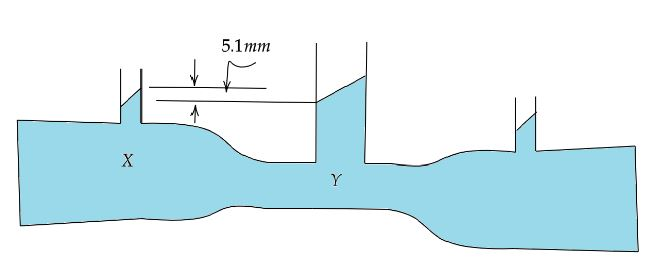
Answer
360.3k+ views
Hint:Here we have to use the formula of the venturimeter. The formula shows the pressure difference between $X$ that is before narrowing of the pipe and $Y$ that is after narrowing of the pipe. After that using the pressure difference formula of fluid we can solve the equation to find the value of speed of water at $Y$.
Complete step by step answer:
As per the problem we have a venturimeter through which water is flowing. The speed of water X is $2\,cm{s^{ - 1}}$. Now we need to calculate the speed of water at Y.
We know venture effect is represented as,
$p_x - p_y = \dfrac{\rho }{2}\left( {v{y^2} - {v_x}^2} \right) \ldots \ldots \left( 1 \right)$
Where, Pressure at position X before the narrowing of the pipe is $px$, Pressure at position Y after the narrowing of the pipe is $p_y$, Density of fluid travelling in the pipe is $\rho $, Velocity of the fluid at position Y is $v_y$ and Velocity of the fluid at position X is $v_x$.
The pressure difference is also represented as,
$p_x - p_y = \Delta h\rho g \ldots \ldots \left( 2 \right)$
Where,
$\Delta h$ is the change in height due to change in before and after narrowing of the pipe.
Now equation equation $\left( 1 \right)$ and $\left( 2 \right)$ we will get,
$\dfrac{\rho }{2}\left( {{v_y}^2 - v_{x^2}} \right) = \Delta h\rho g$
Now cancelling the common terms we will get,
$\dfrac{1}{2}\left( {{v_y}^2 - {v_x}^2} \right) = \Delta hg$
We know,
$\Delta h = 5.1mm = 0.51cm$
$\Rightarrow v_x = 2cm{s^{ - 1}}$
$\Rightarrow g = 10\,m{s^{ - 1}} = 1000\,cm{s^{ - 1}}$
Now putting the given values in the above equation we will get,
$\dfrac{1}{2}\left( {{v_y}^2 - {2^2}} \right) = 0.51 \times 1000$
Now on rearranging and solving further solving we will get,
${v_y}^2 = \left( {510 \times 2} \right) + 2 = 1024$
Hence we can say the speed of water at Y is $32\,cm{s^{ - 1}}$.
Therefore the correct option is $\left( B \right)$.
Note:Here we converted all the units of length in centimeter as our option is given in centimeter. Remember that a venturimeter is a device which is used to measure the rate of flow of fluid flowing through a pipe. The principle of venturimeter is that when a fluid flows through it, it’s acceleration in the convergent section and decelerates in the divergent section which results in drop in static pressure.
Complete step by step answer:
As per the problem we have a venturimeter through which water is flowing. The speed of water X is $2\,cm{s^{ - 1}}$. Now we need to calculate the speed of water at Y.
We know venture effect is represented as,
$p_x - p_y = \dfrac{\rho }{2}\left( {v{y^2} - {v_x}^2} \right) \ldots \ldots \left( 1 \right)$
Where, Pressure at position X before the narrowing of the pipe is $px$, Pressure at position Y after the narrowing of the pipe is $p_y$, Density of fluid travelling in the pipe is $\rho $, Velocity of the fluid at position Y is $v_y$ and Velocity of the fluid at position X is $v_x$.
The pressure difference is also represented as,
$p_x - p_y = \Delta h\rho g \ldots \ldots \left( 2 \right)$
Where,
$\Delta h$ is the change in height due to change in before and after narrowing of the pipe.
Now equation equation $\left( 1 \right)$ and $\left( 2 \right)$ we will get,
$\dfrac{\rho }{2}\left( {{v_y}^2 - v_{x^2}} \right) = \Delta h\rho g$
Now cancelling the common terms we will get,
$\dfrac{1}{2}\left( {{v_y}^2 - {v_x}^2} \right) = \Delta hg$
We know,
$\Delta h = 5.1mm = 0.51cm$
$\Rightarrow v_x = 2cm{s^{ - 1}}$
$\Rightarrow g = 10\,m{s^{ - 1}} = 1000\,cm{s^{ - 1}}$
Now putting the given values in the above equation we will get,
$\dfrac{1}{2}\left( {{v_y}^2 - {2^2}} \right) = 0.51 \times 1000$
Now on rearranging and solving further solving we will get,
${v_y}^2 = \left( {510 \times 2} \right) + 2 = 1024$
Hence we can say the speed of water at Y is $32\,cm{s^{ - 1}}$.
Therefore the correct option is $\left( B \right)$.
Note:Here we converted all the units of length in centimeter as our option is given in centimeter. Remember that a venturimeter is a device which is used to measure the rate of flow of fluid flowing through a pipe. The principle of venturimeter is that when a fluid flows through it, it’s acceleration in the convergent section and decelerates in the divergent section which results in drop in static pressure.
Recently Updated Pages
Who among the following was the religious guru of class 7 social science CBSE

what is the correct chronological order of the following class 10 social science CBSE

Which of the following was not the actual cause for class 10 social science CBSE

Which of the following statements is not correct A class 10 social science CBSE

Which of the following leaders was not present in the class 10 social science CBSE

Garampani Sanctuary is located at A Diphu Assam B Gangtok class 10 social science CBSE

Trending doubts
A rainbow has circular shape because A The earth is class 11 physics CBSE

Which are the Top 10 Largest Countries of the World?

How do you graph the function fx 4x class 9 maths CBSE

Fill the blanks with the suitable prepositions 1 The class 9 english CBSE

The Equation xxx + 2 is Satisfied when x is Equal to Class 10 Maths

Find the value of the expression given below sin 30circ class 11 maths CBSE

What is the length of the alimentary canal in human class 11 biology CBSE

Give 10 examples for herbs , shrubs , climbers , creepers

What is BLO What is the full form of BLO class 8 social science CBSE





